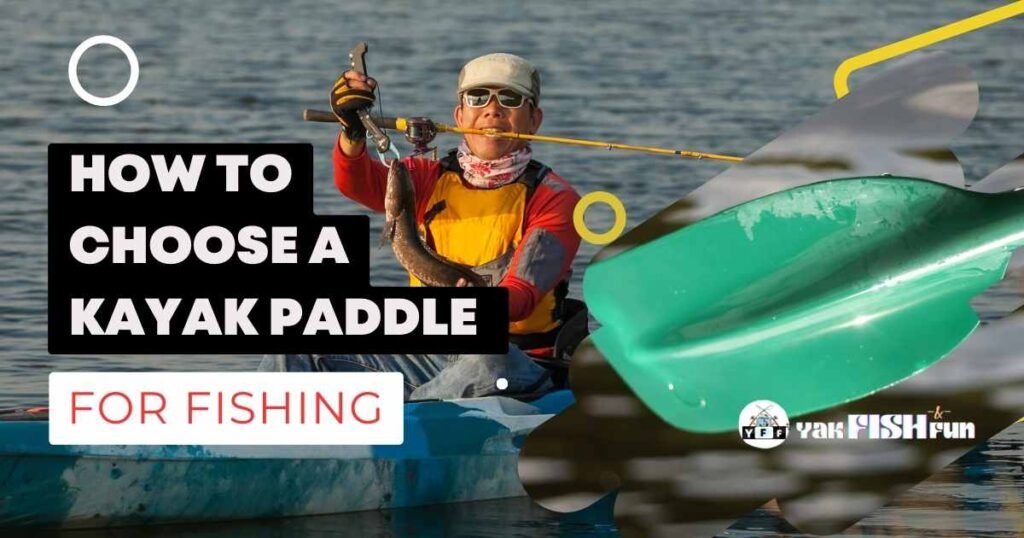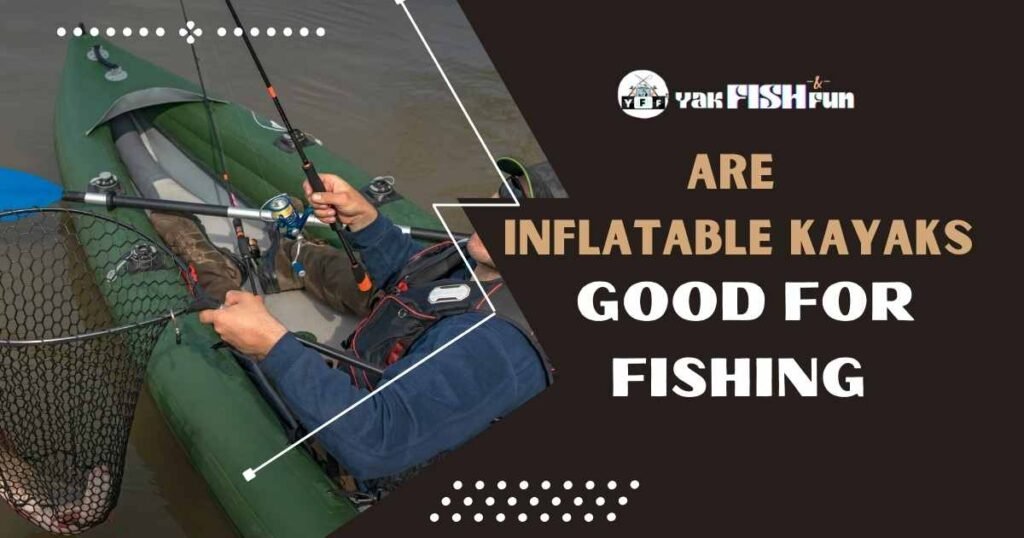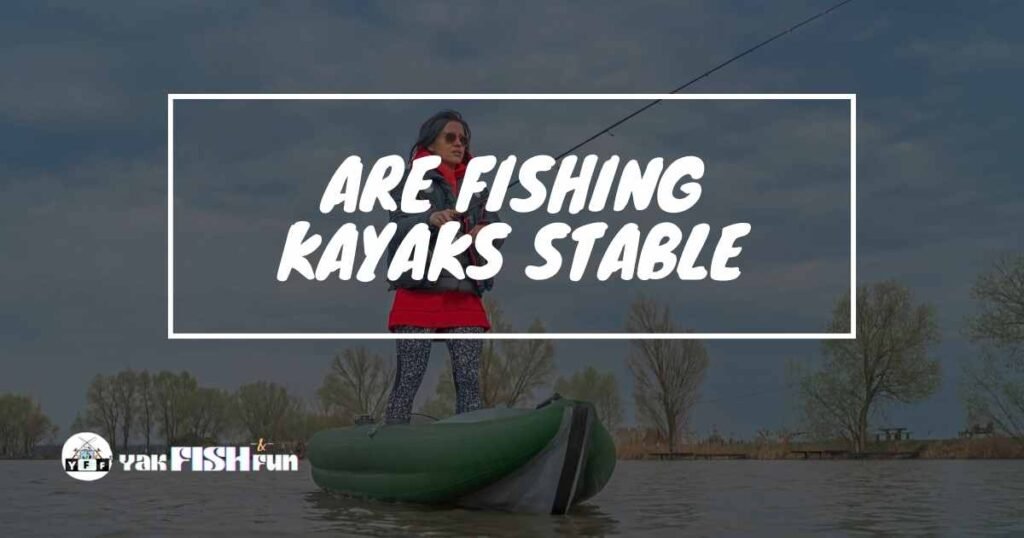Selecting the right kayak paddle for fishing is a pivotal decision that can significantly impact your overall angling experience. A well-chosen paddle ensures efficient propulsion and contributes to your comfort and control of the water.
It’s about enhancing your maneuverability and efficiency while minimizing fatigue and discomfort. Where precision and mobility are essential, understanding the nuances of paddle selection becomes paramount.
This guide will delve into the intricacies of choosing the perfect kayak paddle for your fishing excursions. We’ll explore the key factors to consider, such as paddle length, blade shape, material, and more, empowering you to make an informed decision that aligns with your fishing style and preferences.
So buckle up, grab a cup of coffee, and let’s get started!
Table of Contents

Finding The Perfect Kayak Paddle For Fishing
Choosing the right paddle is essential for a successful and enjoyable experience on the water. With so many options available, it can be overwhelming to determine which kayak paddle is best suited for your fishing needs.
Length Matters
The length of your kayak paddle plays a crucial role in how efficiently you can maneuver your fishing kayak. A too-short paddle may result in inefficient strokes, while one that is too long can cause discomfort and fatigue. To find the proper paddle length, consider your fishing kayak’s width and height.
As a general rule of thumb, add 10-12 inches to the width of your kayak for low-angle paddling or 6-8 inches for high-angle paddling.
Materials and Blade Shape
The materials used to make a kayak paddle really matter for how well it works and how long it lasts. Fiberglass paddles are light and strong, which is great for people who want to paddle easily in their free time. Carbon fiber paddles are even stronger for their weight, but they cost more. Aluminum paddles are cheaper but they can be heavy.
The shape of the blade at the end of the paddle also matters. Wide blades give you more power with each stroke, which is good if you paddle at a steep angle or in strong currents. Narrow blades need less effort for each stroke, which is good for easygoing paddling or calm waters when you want to paddle efficiently.
Consider Other Relevant Features
In addition to length, materials, and blade shape, there are other features worth considering when choosing a kayak paddle for fishing:
- Paddle Size: Adjustable-length paddles allow you to adapt to various conditions and kayak styles.
- Angle Paddles: Some paddles can change the angle of the blades so you can set them just right for the best performance.
- Durability: Look for a paddle that can withstand the demands of fishing, such as impact-resistant materials or reinforced blades.
- Grip Comfort: A comfortable grip is essential for prolonged use. Consider paddles with ergonomic designs or cushioned grips.
- Weight: Lighter paddles reduce fatigue during long fishing trips but may come at a higher cost.
Connecting Through Personal Experience
I love fishing from a kayak, and I know how crucial it is to pick the perfect paddle for the job. Once, while I was wrestling with a strong fish, I saw how important it is to have a paddle that can handle hard hits without breaking.
Also, having a paddle that can change the angle of the blades helped me adjust my paddling to the wind, making me more efficient on the water. These experiences taught me what works best.
What To Look For In A Kayak Paddle For Fishing
There are several important factors that you should consider. The paddle you select can greatly impact your comfort and performance during those long fishing trips. Here are some key factors to keep in mind when selecting a fishing kayak paddle:
The weight of the paddle affects comfort during long fishing trips
The weight of the paddle really matters, especially if you’ll be on the water for a long time. A lighter paddle makes it easier on your arms, so you can have a great time on the kayak without feeling tired. Try to find paddles made from light stuff like aluminum, carbon fiber, or fiberglass.
Blade shape determines stroke efficiency and control in water
The shape of the paddle’s blade is really important for how well you can paddle and control your kayak. There are different shapes, and they each have their own strengths. Some blades, called “dihedral,” make you more stable and help you paddle better in the wind. They’re great for longer trips or when it’s windy. Others, like “symmetrical” blades, are good for beginners because they work well in many situations and are easy to use.
Adjustable shaft length allows customization based on the user’s height and kayak width
An adjustable shaft length allows you to customize your paddle based on your height and kayak width. This feature ensures that you can find an optimal length that matches your specific needs for comfortable paddling. It also allows you to make adjustments depending on whether you prefer a high-angle or low-angle stroke.
Material options vary in price, durability, and performance
The material used in constructing the paddle greatly impacts its price, durability, and performance. Here are some common materials used:
- Aluminum: Affordable option with decent durability but slightly heavier.
- Plastic: Budget-friendly choice suitable for occasional use but lacks strength.
- Nylon blades: Lightweight and durable option that offers good performance.
- Carbon fiber: This material is really good because it’s strong for its weight, but it costs more.
- Fiberglass blade: Provides a balance between durability and weight, making it a popular choice among anglers.
To find the right material for what you need, think about your budget, what you plan to use it for, and how well you want it to perform.
When you think about these things, picking the right kayak paddle for fishing is simpler. Keep in mind the weight, the shape of the paddle, how long it can adjust, and the materials it’s made of. When you choose a paddle that fits your needs, you’ll have a better time fishing on the water.
Types Of Kayak Paddles
Think about the different types of paddles. Each type is made for different ways of paddling and different places you’ll be in. Here are the main types of kayak paddles you should know:
Touring Paddles
Touring paddles are versatile options suitable for general kayaking purposes. They’re shaped to make it easy to paddle forward and work well for relaxed kayaking or exploring. They give you a good mix of power and control, so they’re great for calm waters or gentle currents. If you like spending a lot of time on the water checking out different lakes and rivers, touring paddles are a good choice for you.
Whitewater Paddles
If you love fishing in fast rivers with lots of rapids, then you should go for whitewater paddles. These paddles are shorter and have blades that look the same on both sides. This design helps you steer easily and make powerful strokes to handle rough waters. Whether you’re dealing with strong currents or avoiding rocks and obstacles, whitewater paddles give you the control and stability you need for an exciting fishing trip in tough places.
Sea Kayaking Paddles
If you’re thinking about long trips on big open water, you should consider using sea kayaking paddles. They are made for this kind of kayaking. These paddles are longer and help you steer well and paddle comfortably, even when the water is rough. Sea kayaking needs you to be strong and stable, so these paddles are great if you want to explore big coastal areas or go deep-sea fishing.
Fishing Kayak Paddles
Fishing kayak paddles are made just for people who fish from kayaks. They usually have extra things that make fishing easier, like a way to get your hooks back, marks to measure fish on the paddle, or even a ruler built in. These paddles are meant to make it easy for you to paddle to your fishing spots and have everything you need right there.
Wing Paddles
Wing paddles are made for competitive kayaking races, like sprints or marathons. They have a special shape that helps you go really fast. But they might not be good for regular kayaking or fishing because they’re designed just for going fast and not for other things.
Selecting the Perfect Blade Material and Shape
Selecting the right blade material and shape is crucial. The blade material affects your paddle’s durability, weight, and efficiency, while the shape determines its performance on the water.
Fiberglass Blades: Durability without Compromising Weight
Many kayak anglers like fiberglass blades because they’re strong but not too heavy. They can take a beating in rough waters and even when you bump into things like rocks or logs. Even though they’re tough, they’re still light, so you won’t get tired quickly during long fishing trips.
One advantage of fiberglass shafts is their ability to flex slightly upon impact with rocks or other hard surfaces. This flexibility helps prevent damage to both the blades and your kayak’s hull. Fiberglass blades provide good power transfer through the water, allowing you to move efficiently with each stroke.
Carbon Fiber Blades: Lightweight Strength for Increased Efficiency
If you want paddles that are super light and make it easier to paddle, go for carbon fiber blades. Carbon fiber is really strong for its weight, so these paddles are super light. This means you can paddle for a long time without getting tired.
Carbon fiber is really stiff, and that helps you push the water harder with each paddle stroke. This means you can go faster and steer better without working too hard. But remember, carbon fiber paddles can cost more than other choices.
Aluminum Shafts: Affordable but Potentially Heavier
If you want something cheaper, think about getting a paddle with an aluminum shaft. They usually cost less, but they can be heavier than paddles with fiberglass or carbon fiber shafts. This extra weight might make you tired if you’re paddling for a long time.
Despite their potential heaviness, aluminum shafts are durable and less prone to damage from rocks or other obstacles. They are also resistant to corrosion, making them suitable for saltwater fishing. If weight is not a significant factor for you and you prioritize affordability, an aluminum shaft with nylon blades could be a good choice.
Exploring Different Blade Shapes
Apart from the material used in the blade construction, the shape of the blade significantly affects your paddling experience while kayak fishing. Here are some common blade shapes and their advantages:
- Dihedral Blades: These blades have a ridge down the middle, which splits them into two angled parts. Dihedral blades help reduce the effect of wind and give stability when you paddle. They’re great for anglers who paddle in windy places or like a smooth and controlled way of paddling.
- Symmetrical Blades: These blades look the same on both sides of the paddle shaft. They’re good for many different kayaking styles, including fishing strokes like sweep strokes or sculling draws.
- Asymmetrical/Bent Shaft Blades: These blades have a slanted shape that makes your hand position feel more natural when you paddle. This helps prevent wrist tiredness and gives you more control, especially in narrow or tricky places like backwaters.
Sizing Guide for Optimal Performance
Choosing the right kayak paddle size is crucial for maximizing your performance on the water. The length of your paddle should be determined based on your height and the width of your kayak. Let’s dive into some key factors to consider when selecting the perfect paddle for fishing.
Taller individuals generally require a longer paddle, while shorter paddlers need a shorter one. The width of your kayak plays a role in determining the ideal paddle length. A wider kayak necessitates a longer paddle to ensure efficient strokes and prevent strain on your body.
Longer paddles give you more power with each stroke because they have more reach and surface area. This helps you paddle through strong currents or windy conditions more easily. But if you often paddle in tight or narrow spaces, shorter paddles give you better control and maneuverability.
The size of the blade on your paddle also matters. It depends on how you like to paddle. If you paddle with a high angle and strong strokes, bigger blades are better because they give you more power and efficiency. If you paddle with a low angle, smaller blades work well because they let you paddle smoothly for a long time without getting too tired.
Durability is also a significant factor when selecting a kayak fishing paddle. You want one that can take a beating and won’t get messed up if it hits rocks or stuff in the water. Look for paddles made from strong stuff like fiberglass or carbon fiber because they are tough but not too heavy.
Considering wind resistance is essential when choosing a proper kayak fishing paddle. Wind can make it hard to steer and move in the water. A longer paddle can help because it reaches above the water, so it doesn’t catch as much wind. This way, you can paddle smoothly even when it’s windy.
To summarize, here are some key points to keep in mind when selecting the right kayak paddle for fishing:
- Determine the appropriate paddle length based on your height and kayak width.
- Longer paddles offer more power, while shorter ones provide better control in tight spaces.
- Consider your preferred paddling style when determining blade size.
- Look for durable materials such as fiberglass or carbon fiber for longevity.
- Factor in wind resistance to ensure optimal performance.
Think about all these things and what you like, and then you can choose the right paddle that makes your kayaking better and helps you paddle well. Happy fishing!
Bottom Line
Choosing the right kayak paddle for fishing is crucial for a successful and enjoyable experience on the water. You can find the perfect paddle that suits your needs by considering factors such as paddle type, blade material and shape, shaft design, and sizing guide. Whether you’re a beginner or an experienced angler, investing in a high-quality fishing kayak paddle will greatly enhance your performance and comfort while out on the water.


